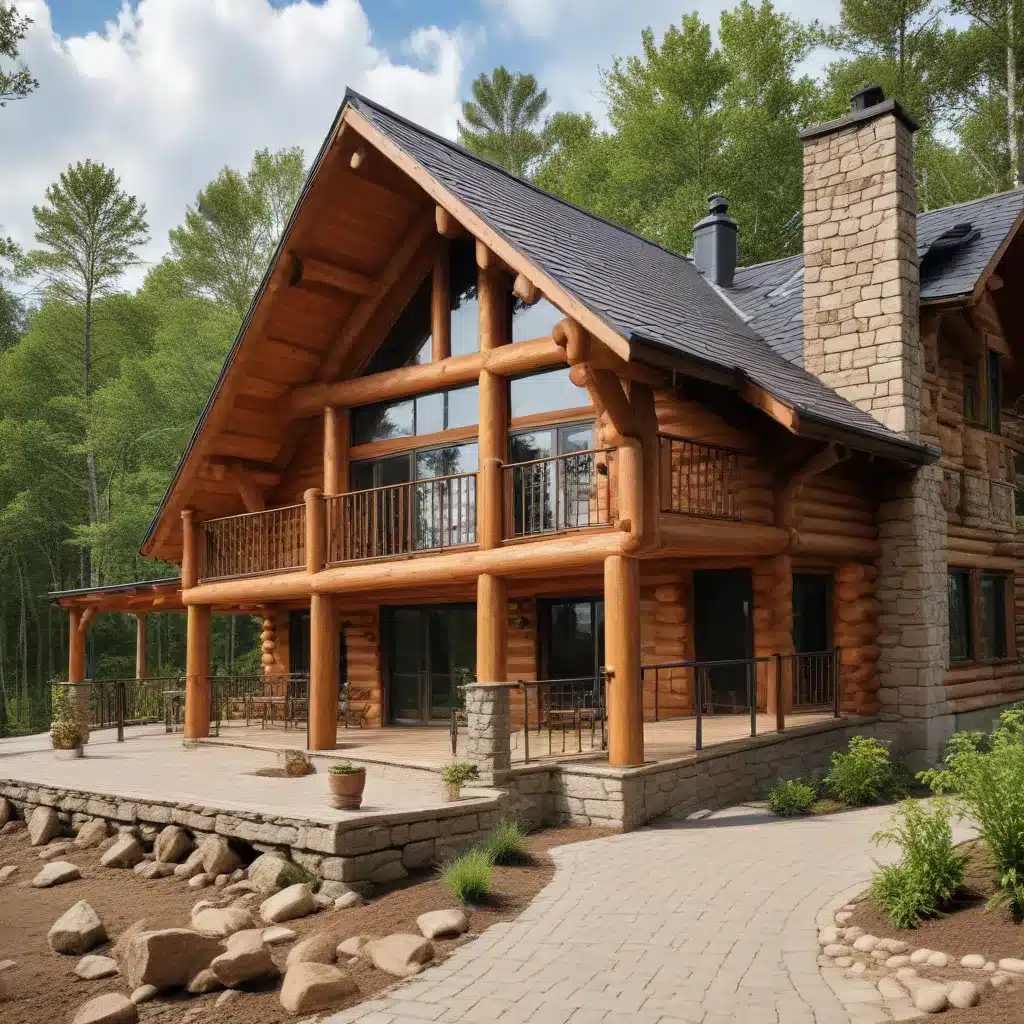
Constructing Resilient Log Homes: Techniques and Materials
Building a log home is a unique and rewarding endeavor, but ensuring its long-term durability and weatherproofing is crucial. Homeowners and builders must carefully consider the various techniques and sustainable materials that can enhance the resilience of these structures against the elements.
One of the primary factors in constructing a weatherproof log home is the selection of appropriate wood species. Hardwoods like oak, maple, and hickory generally offer greater resistance to weathering and insect damage compared to softer woods. These durable species can better withstand the stresses of expansion and contraction caused by temperature and moisture fluctuations, helping to minimize gaps and cracks over time.
In addition to choosing the right wood, the seasoning and drying process is crucial. Properly dried and seasoned logs are less susceptible to shrinkage and air leaks, which are common issues that can compromise a log home’s energy efficiency and structural integrity. Manufacturers and experienced builders often opt for kiln-drying the logs before installation to ensure optimal moisture content and minimize future problems.
Strategies for Preventing Air Leaks and Moisture Intrusion
Air leaks are a significant concern in log homes, as the natural movement and settling of the logs can create gaps and openings over time. To address this challenge, sealants and gaskets are commonly used to create a tight barrier between the logs. High-quality caulking compounds formulated specifically for log structures are essential for maintaining a weatherproof seal and preventing air and water infiltration.
Proper insulation is another critical element in enhancing the durability and energy efficiency of log homes. While the logs themselves provide some insulative value, supplemental insulation materials like rigid foam boards or blown-in cellulose can significantly improve the overall thermal performance of the structure. This helps regulate temperature, reduce energy consumption, and protect the logs from temperature-related stress and moisture buildup.
Roofing and Wall Treatments for Weatherproofing
The roof is a crucial component in safeguarding a log home from the elements. Durable and weather-resistant roofing materials, such as metal or tile, are often preferred over traditional asphalt shingles. These options not only enhance the longevity of the roof but also provide superior protection against wind, rain, and snow.
Treating the log walls is another essential step in weatherproofing a log home. High-quality sealants and preservatives are applied to the exterior of the logs to create a protective barrier against moisture, UV radiation, and insect damage. Regularly reapplying these treatments every few years is necessary to maintain the long-term durability and visual appeal of the logs.
Maintaining Log Home Longevity
Proper maintenance is key to ensuring the longevity of a log home. Regular inspections and preventative maintenance measures, such as identifying and addressing any cracks, gaps, or signs of deterioration, can help mitigate costly repairs down the line. Homeowners should also be vigilant in monitoring for any signs of insect infestations or wood rot, which can compromise the structural integrity of the home if left unchecked.
Jorgensen Log Homes, a leading provider of custom log homes in the United States, recommends a comprehensive approach to log home maintenance. This includes cleaning the log surfaces, repairing and reapplying sealants and stains, and addressing any necessary structural or weatherproofing issues in a timely manner. By prioritizing ongoing maintenance, homeowners can ensure the long-term durability and charm of their cherished log homes.
Energy Efficiency Considerations for Log Homes
While log homes are known for their rustic appeal, they can also be designed and constructed to be highly energy-efficient. The thermal mass of the logs, when combined with proper insulation and air sealing, can provide excellent temperature regulation and energy savings compared to traditional frame construction.
One effective strategy is to utilize high-performance insulation materials, such as rigid foam boards or spray foam, in strategic areas like the walls, roof, and foundation. This, along with meticulous air sealing around windows, doors, and other penetrations, can significantly improve the energy efficiency of a log home, reducing heating and cooling costs.
| Energy Efficiency Feature | Average Cost (USD, as of September 2024) |
|---|---|
| Rigid Foam Insulation (R-value 5 per inch) | $2.50 – $4.00 per square foot |
| Spray Foam Insulation (R-value 6-7 per inch) | $3.50 – $6.00 per square foot |
| High-Performance Windows (R-value 4-6) | $40 – $80 per square foot |
| Energy-Efficient Doors | $800 – $2,500 per door |
By incorporating these energy-efficient features, log home owners can enjoy the timeless charm of their homes while benefiting from reduced energy consumption and lower utility bills.
Customizing Log Homes for Regional Climate Conditions
The optimal weatherproofing strategies for log homes may vary depending on the local climate and environmental conditions. Homeowners and builders should carefully consider the specific challenges posed by their region, such as heavy snowfall, intense sunlight, or high humidity, and tailor their approach accordingly.
In regions with extreme temperature fluctuations or significant precipitation, enhanced insulation and air sealing become even more crucial to maintain the home’s energy efficiency and prevent moisture-related issues. Conversely, in hot and dry climates, additional UV protection and specialized wood treatments may be necessary to preserve the integrity of the logs.
By taking a customized, climate-specific approach to log home construction and weatherproofing, homeowners can ensure their cherished investments remain resilient and comfortable for decades to come.
Conclusion
Constructing a weatherproof and durable log home requires a multifaceted approach that considers the selection of suitable materials, meticulous construction techniques, and ongoing maintenance. By prioritizing energy efficiency, moisture control, and structural integrity, homeowners can enjoy the timeless charm and character of log homes while safeguarding their investment for the long term.
Whether you’re planning to build a new log cabin or maintain an existing one, the strategies outlined in this article can serve as a valuable guide to enhancing the weatherproofing and longevity of your cherished log home. By staying informed and proactive, you can ensure your log home remains a warm and welcoming haven for years to come.


